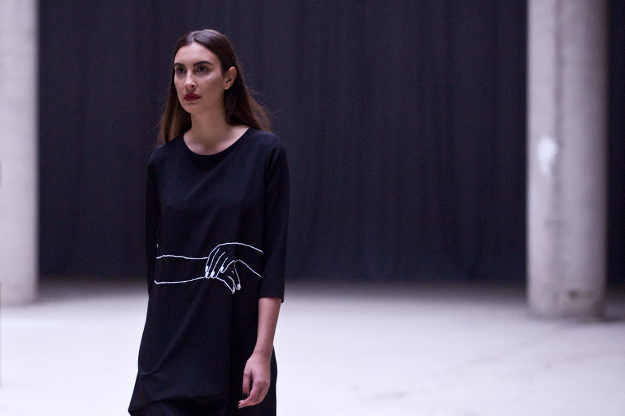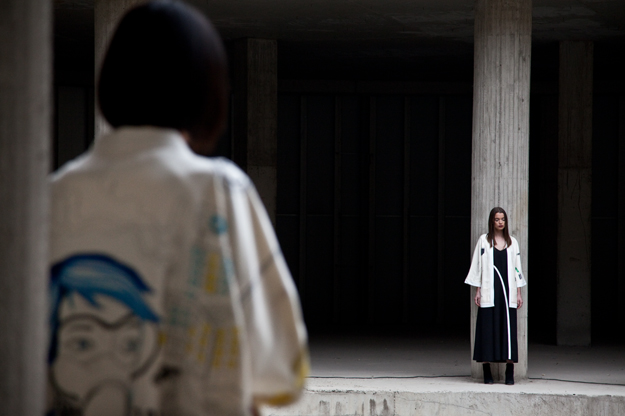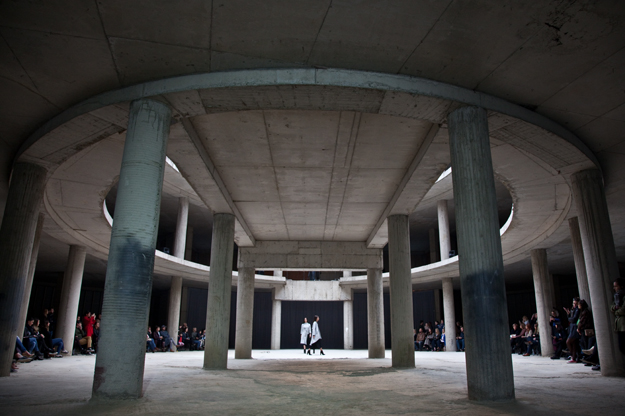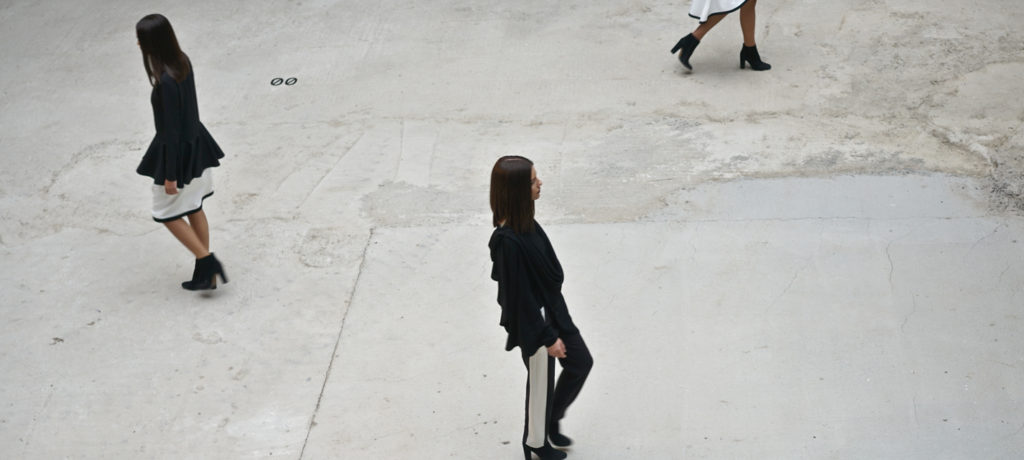Venera Mustafa is a bit different to the classical fashion designers we usually see. If you expect to see her new collections at a five star hotel, then you will be waiting in vain. She says that she is not pretentious; the ready-to-wear clothing she designs is presented in different locations around Prishtina, which is certainly not considered a five star city.
After finishing fashion studies at Ecole Superieure des Arts et Techniques de la Mode (ESMOD), a private fashion school in Paris, she returned to Prishtina to start her own line of clothing. She established her veneramustafa label in 2010, and from the beginning tried to make her line and her atelier warmer and more human, and to make people feel closer and more comfortable, contrary to the feelings of distance and superiority offered by luxurious fashion shops.
All of her collections have had a peculiar trademark attached, either in launching – her fashion shows “ë” and “Sonder” were more artistic performances than fashion parades – or in the making and design – she often collaborates with other artists, mixing their work with hers, such as the visual artist Bujar Sylejmani who painted directly onto the material.
Her new collection “Broka,” for autumn/winter 2016-17, was launched last weekend in an unfinished indoor parking space, and for the first time it was recognisably a fashion parade, although still very different; not just the clothing, but even the setting and the parade format were clearly drenched in her trademark veneramustafa style.
“I like playing with the graphical parts, I like graphic design overall,” says Mustafa, who before pursuing fashion studied sculpture at the University of Prishtina. “Structures, lines and architecture or minimalism I find very attractive, so I include them time after time.”
In her “Broka” collection, she found the difference between black and white, “the bluntness of it,” intriguing. The end result is the charming design of around 90 pieces of clothing in a beautiful merging of black, white and “Fifty Shades of Grey,” featuring the drawings of Bujar Sylejmani and photo printing by Majlinda Hoxha.
Mustafa specialized in men’s fashion in Paris so that she could design men’s clothing as well as women’s. So why are all her collections made for girls? She says that there is a lack of interest in fashion among men. Women attach more importance to their appearance than men — although she adds that, lately, that has started to change.
Mustafa thinks that people in Prishtina have a taste for dressing well, but still dress uniformly; we do not have an individual style but dress more or less similarly. In a small city like Prishtina, being different with strong individuality in clothing puts you in the spotlight, and not many are ready to face the pressure that comes with it. But why is it important to have an individual style?
“You express yourself with what you wear,” says Mustafa, attaching importance to both detail and overall dress style. “You show the kind of personality you have; the way you tie a scarf shows a piece of your inner self, or what you wish to express with it.”
It is fairly easy being a VIP in Kosovo; we have lots of TV stations and little content, meaning not much is happening. But being a true artist doing what you love – in this case fashion design – requires more than appearing on TV, according to Mustafa: it also requires hard work and passion. To all those who are taking their first steps in the fashion world, Mustafa strongly recommends striving for those values, rather than presenting five pieces of clothing on TV and claiming to be a fashion designer.
K2.0 spoke to Venera Mustafa for a more detailed glimpse into her latest work, and her points of view on different matters concerning the world of fashion.
K2.0: First let’s talk about your newest collection, “Broka.” What makes it different from your previous work?
Venera Mustafa: I am trying in each collection to bring something new; different kinds of collaborations with my colleagues – or more accurately my friends. Also experiments with textile, because designing clothing as a fashion designer for a certain time has its challenges but also its monotony, therefore you need to do something more refreshing.
For example in this collection there are prints and drawings made directly onto the textile, which is a more complicated process because the material has to be suitable. The drawings are made by Bujar Sylejmani and are hand painted directly onto the material, whereas the photography is by Majlinda Hoxha, with whom I have cooperated before, and in other fields as well.

I often like to get out of the box of being a fashion designer, or the box of working only within the clothing industry, and to incorporate collaborations with artists, also adding some elements from our traditional clothing – although visually it’s not that obvious, in each collection there has been something [traditional].
For instance, I very much like the lines of ‘tirqe’ [traditional Albanian clothing]: the difference between the white and black, the bluntness of it. I always liked to play with that, and this collection is like that – monochromatic. The colors that dominate are the white and black and grey. So maybe that is more interesting than the collaborations I have had before.
Tell us about your other collaborations with artists, maybe those that you hold close to your heart?
I was in the faculty [of sculpture] with all of them, with Jakup [Ferri], Bujar [Sylejmani], and many others. Not with Majlinda [Hoxha], but we are very close. I finished at the Faculty of Sculpture here [in Prishtina], and the friendships have remained since. Then when I got back from Paris, after finishing studying fashion, I started to work. Later I thought, ‘Why not do a collaboration to conjoin these two fields [fashion and sculpture]?’ I found it very interesting, because it enabled me to show some art through fashion. Not just to create a seasonal fashion collection, because we know that they are more or less daily outfits, but to find an element which sets it apart from other outfits, apart from the cutting, colors and volume.
So the collaborations came about very organically, like friends talking and proposing to do things a certain way, and deciding to try it. There’s also this process which I like very much, the producing part; because maybe you make plans beforehand in vain, saying, ‘I want this to be like this,’ ‘this will be done like this,’ and ‘this will look that,’ but during the process the major parts will change, and as a result you could have a product or a work much more beautiful than previously thought or foreseen.
In your latest collection you have collaborated with two artists and friends of yours, Bujar Sylejmani and Majlinda Hoxha. What do they represent with their work?
It is more or less their world. With Majlinda we have more or less the same visual concept. So it’s not that big a problem, we don’t have many discrepancies in style or whatever. We are very similar. With Bujar it is different. He is more graphic. In fact, he says that he does not have a style of his own, so I did not interfere. There is no specific theme, it is completely Bujar’s world, how he felt in those moments. For me it is very special, as there were no limitations in expression. He could draw however he pleased. Complete freedom of expression.

You had a very interesting collection in which the letter ë appears on all your works. Other works of yours also have some interesting story behind them. Tell us about some of your recent works, and what it is that you want to express with them?
The letter “ë” was the name of my collection. Every time I read something on [social media] or hear something on TV, the letter ë is completely skipped. Maybe we don’t always have to type it since we use the Gheg dialect, but we shouldn’t omit it from our speech.
It was very spontaneous. I was watching the news and I noticed the absence in our expression. We’re always kind of in the middle, between Tosk and Gheg. But I think we should not exclude ë, as it is a beautiful letter. So I thought it would be interesting to make a collection with ë. I was skeptical as to whether it would work, as it is very graphic. It could be too evident, since it is impossible not to notice the ë-s on somebody since they are spread out and so clear.
I like to play with these graphic parts. I like graphic design in general; the structures, lines and architecture. I like minimalism and I include it in my work from time to time. This time I printed Majlinda’s photos, which again is a kind of graphic system, as they are printed like squares.
There are also the numbers [collection]. I’ve never been good with numbers. Still, I like them visually. The collection is called “Sonder.” It’s a word that actually illustrates the lives of people in a way: When you see people that you don’t know and you wonder about the kind of life that person has, the word for that is sonder.
There is a book [“Dictionary of Obscure Sorrows,” by John Koenig] for situations that are hard to explain. He named these situations that we cannot explain in words. So I thought it was an interesting concept, and I used the numbers to represent the lives of all the people we have thought about, people who we do not know but who have stirred our imaginations with questions like, ‘I wonder if he has a grandmother or grandfather or aunt?’ It is those absurd situations that have happened very often to me.
As for the “Broka” collection, the cooperation was really organic, we were not limited to saying, ‘Look, I want to go in this direction so you have to follow me’. It was more organic like ‘You do your part, I do mine, and we arrange it afterwards so it fits a line of continuum, a kind of vibe of clothing.’
And it was hard to decide on a name, but it was based on the colors that characterize this collection. I searched the word ‘monochrome,’ and whether there is a word that describes two colors, or a monochrome, one color with many nuances. And I found it in an Albanian dictionary.
Broka-broka is used when you want to explain something colorful — broka-broka black and white, with colors. It seemed very beautiful to me and I used only one part [of this word], broka.
Looking back at some of your collection launches, one can say that they were more artistic performances than classic fashion runway parades. Why did you choose to do them this way?
I tried to do something more interesting. Maybe to have the exhibition spirit, that feeling of being closer to what is being exhibited. In which, depending on the set and setting, you as a viewer can analyze, and maybe come close and touch it. In a few words, to be on the same level, rather than looking up to it.
So I wanted my approach to be closer, because I have felt the feeling of coldness – not here, because here there is no fashion industry. But when I have been to luxury stores, they were very well laid out, but I always felt anxious, as if I’d break something if I touched it.
This created a barrier, because when you go to designers, or to places that are really dazzling, you don’t feel inferior, but you are reluctant to approach them with warmth and closeness as a client. So I wanted to be a bit more free, more normal, more human. Because it is not something that must be idealized, it is something that is used, worn, seen, touched, liked or disliked.
One other thing that has become a trademark of yours is the choice of location for your launches. They are not places where most fashion events or runways take place. What do you look for when choosing the location?
I like it a lot, [the process of] finding the location, because it gives me some perspective, some creative imagination. I pick them while driving around in my car in Prishtina and outside of it, because I like to drive.
Most ideas come to me while driving; even when I’m stuck in traffic and I see a space I always connect it to a way in which I could utilize it for shooting, for an event. Everything for me is linked to my work. Sometimes it turns out to be a hard nut, because I need to work a lot to make a space functional but in most cases, or up until now, they’ve turned out interesting. “Broka” was held close to the hospital. In the garages next to it there is a round space which was never used. They started to make a garage but it’s been abandoned in the last 7 to 8 years.

It’s very hard to find spaces in Prishtina for these kinds of events. It’s not that our city is big. And there is no designated space, we don’t even have a city gallery. So we are conditioned — some designers do them in hotels, Swiss Diamond or whatever. But I’m attracted to these other places, I look for something that more or less offers the same accommodation or spirit that Prishtina offers, because Prishtina is not a five star city.
What does it mean to be a fashion designer today, and what does it mean to be a fashion designer in Kosovo? Is it just about making good looking clothes, or something more, like making a statement or expressing something with it?
To have a big fashion show you need a fashion industry, and that we don’t have, so I always try to stay within the contours of our city, of what can be done in Prishtina. Something that fits Prishtina, not London or Paris … to sum up the society and our mentality in a way.
Everyone creates what they themselves want to represent with their brand. From the beginning, I set myself some directives and goals. I usually set a line that I follow and then it’s easier to work in a continuum, because you already have a message.
I always use these graphics and collaborations, my lines, the architectural part, the cuts; I have an aesthetic, a message. But you can have a social and political approach, if you give it one. Some time ago, I made some “Visa isa sa a” bags [a question to Prime Minister Isa Mustafa asking how long it will be until Kosovoars have visa liberalisation within the Schengen Zone] but they were not part of any collection, they were just spontaneous.
It is not necessary to have a message. Even though it is not an industry, it is a business whether we like it or not, so most big companies outside the country naturally convey trends and a kind of spirit, but not a direct message per se like ‘make love not war.’ But they can come in different forms, conveyed through clothes. There are designers who have that [direct] approach, but not always.
How about the fashion scene in Kosovo? Are the youth, or people in general, interested in following the fashion trends? What about men?
I have studied women’s fashion but I specialized in men’s clothes. I took it because I wanted to cover both genders if necessary. I started with men’s clothes as well, but there was not much interest. Anyway I’m talking about 5 years ago, because when I started there was no ‘ready-to-wear’ clothing, let alone clothing only for men.
So [my work and arrival] was a kind of novelty in the market. First of all as a designer who does not take orders. Here the perception was that designers are tailors. … Designers are not only tailors. It is offensive to go to a fashion designer with a Vogue magazine and say, ‘Make me this Valentino or Versace.’ Because it’s like, ‘I’m not looking at your things, I don’t care about your work, just make it look like in this magazine.’
"We have clothes in abundance, but it's important to discover your originality."
As for interest, naturally women are the ones who pay more attention to themselves, men not so much, even though that has started to change a bit.
It’s not that we dress badly, I think that we dress well, but still we have some kind of uniform dress code. It’s not that we have unique individual styles, we dress similarly. You express yourself with what you wear, you show a part of character, who you are. The way you wear a scarf says lot about you, or what you want to say.
As a notable fashion designer, what advice could you give to those who are new in this field?
When I finished university I worked for about a year in the industry before opening my place. I saw that there is a certain euphoria about it that immediately pushes you, when you finish university, to start a collection of your own.
But it is really hard to stay with one collection or to have a continuum of collections. You can’t just say, ‘I made five dresses and now I’m a designer.’ I’ve gained a lot of experience, even through internships; even though I finished fashion school, I think I obtained 80 percent of my knowledge from these internships.
I know that in Kosovo it’s really easy to be a VIP, everyone has access to TV, everyone knows someone that works there, it’s like we’re one big family. So it’s not like, ‘Hey, let’s appear on TV,’ but you have to work with what you are passionate about, that means something. And that doesn’t happen in a day, it happens with time, and work.
We can’t rush just to say that I’m on TV, and now I’m a designer. We have to work, and not just in the sense of sewing, but to work for ourselves, to create a sort of world, a sort of image, and to build a character. To focus more on finding what is inside of you, because we have clothes in abundance, but it’s important to discover your originality.K
Photos: Majlinda Hoxha.





